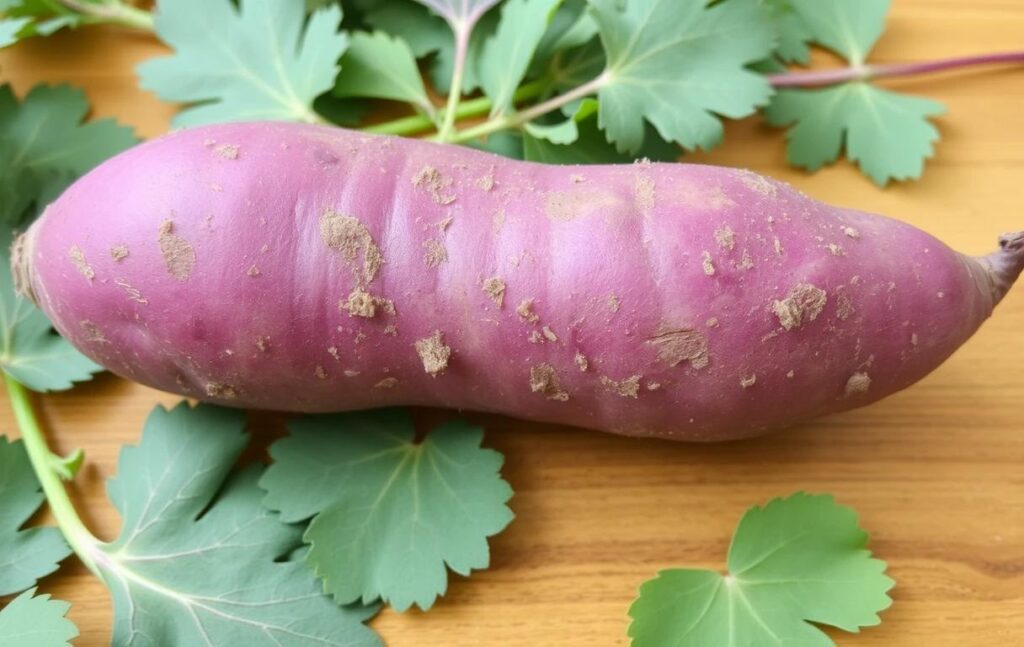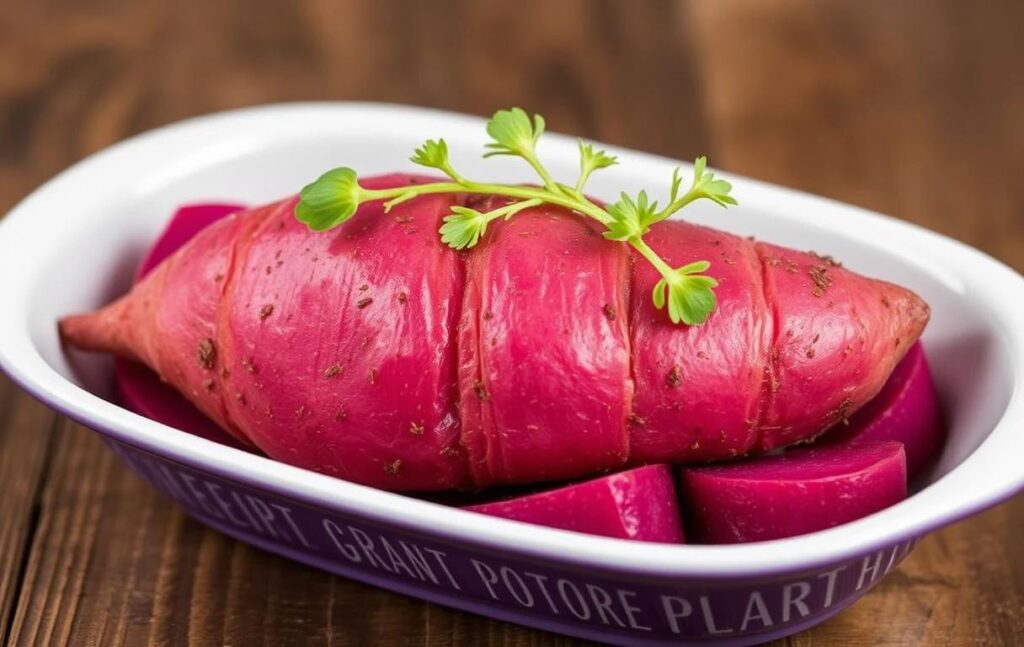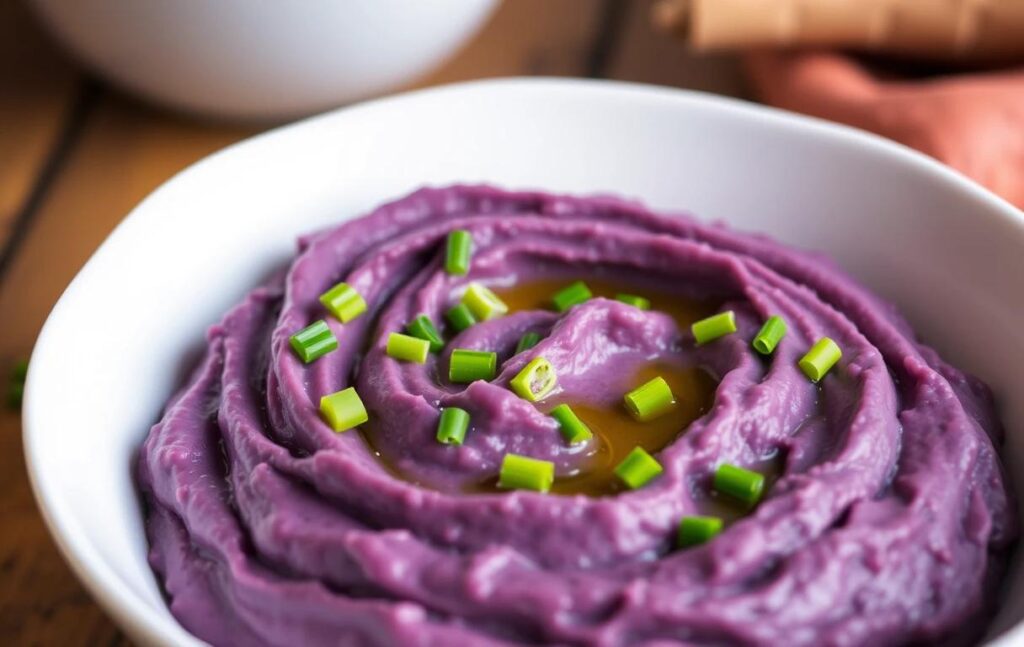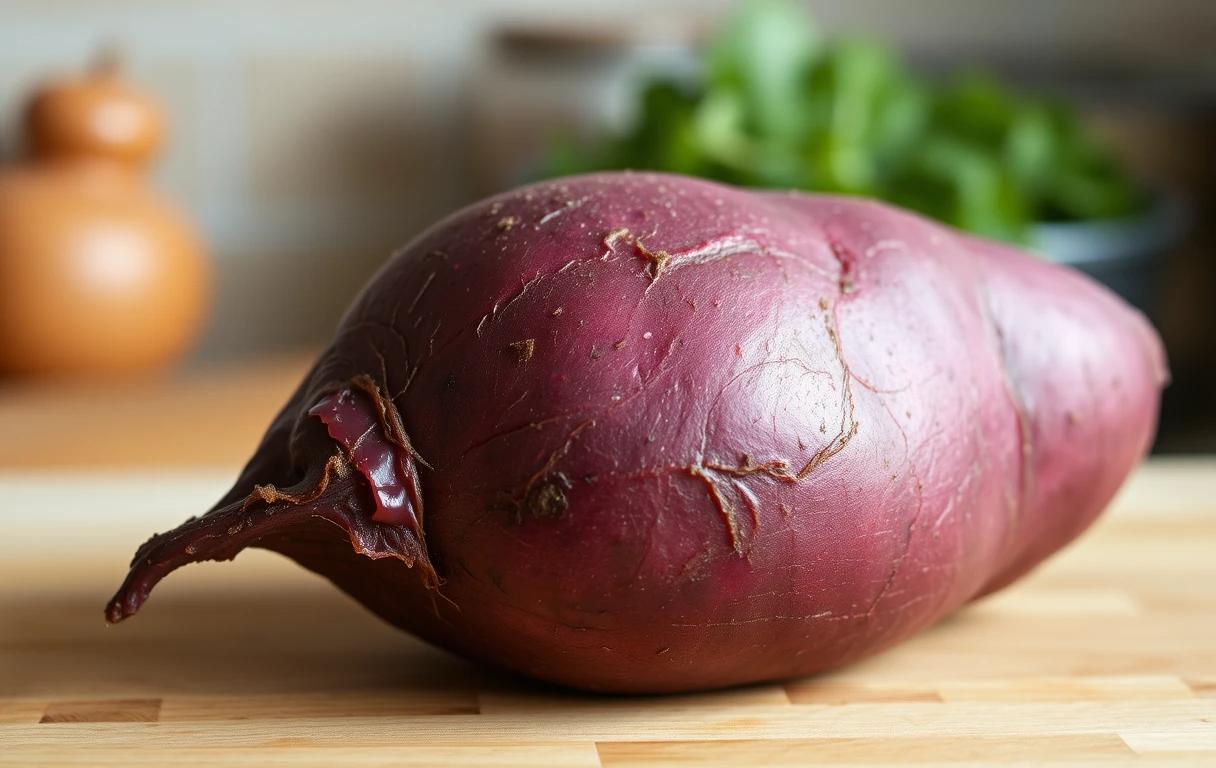Introduction to Purple Sweet Potato
The purple sweet potato, a root vegetable gaining global recognition, is celebrated for its vibrant color, unique flavor, and remarkable health benefits. Originating primarily in Central and South America, it has been cultivated for centuries and is now a staple in various cuisines worldwide, particularly in Asia, Africa, and the Pacific Islands.
Characteristics and Appearance
Purple sweet potatoes are distinguished by their striking deep purple flesh and skin, which are a result of anthocyanins—naturally occurring pigments with potent antioxidant properties. These potatoes are slightly denser and less sweet compared to their orange counterparts, offering a mildly earthy and nutty flavor that complements both savory and sweet dishes.
Nutritional Profile
Purple sweet potatoes are a powerhouse of nutrients. They are rich in:
- Dietary Fiber: Aiding digestion and promoting gut health.
- Vitamins: Particularly vitamin A, vitamin C, and some B vitamins.
- Minerals: Including potassium, calcium, and magnesium.
- Antioxidants: Especially anthocyanins, which are linked to anti-inflammatory and anti-cancer properties.
Health Benefits
- Antioxidant Power: The anthocyanins help combat oxidative stress, reducing the risk of chronic diseases such as heart disease and cancer.
- Immune Support: High levels of vitamin C and beta-carotene boost the immune system.
- Blood Sugar Regulation: The complex carbohydrates and fiber content contribute to slower digestion, preventing spikes in blood sugar levels.
- Eye and Skin Health: The rich vitamin A content supports vision and skin integrity.
Culinary Uses
Purple sweet potatoes are versatile and can be baked, boiled, roasted, or steamed. They are popular in desserts such as pies, cakes, and ice cream, as well as in savory dishes like soups, casseroles, and chips. Their vibrant color also makes them a favorite for decorative plating and creative recipes.
Cultivation and Sustainability
Purple sweet potatoes thrive in warm climates and are relatively easy to grow. They are drought-resistant and require fewer chemical inputs, making them an environmentally sustainable crop. Their ability to adapt to diverse soil conditions also contributes to food security in regions where other crops may struggle.
Overview of Purple Sweet Potato
The purple sweet potato is a visually striking and nutrient-rich root vegetable known for its deep purple flesh and skin. Its vibrant color is due to the presence of anthocyanins, powerful antioxidants that also give blueberries and red cabbage their hues. These sweet potatoes are slightly denser and less sweet than their orange or white counterparts, with a mild, earthy flavor that makes them versatile in both sweet and savory recipes.
Originating in Central and South America, the purple sweet potato has become a staple in various regions, especially in Asia, the Pacific Islands, and Africa, where it is valued for its health benefits, adaptability, and culinary potential.
Key Nutritional Benefits:
- High in Antioxidants: Rich in anthocyanins, promoting cell protection and reducing inflammation.
- Rich in Fiber: Supports digestion and gut health.
- Vitamin Powerhouse: Excellent source of vitamin A (beta-carotene), vitamin C, and other B vitamins.
- Minerals for Health: Provides potassium, magnesium, and calcium, contributing to overall well-being.
Purple sweet potatoes are commonly baked, boiled, steamed, or roasted and are featured in both traditional dishes and creative culinary innovations such as ice creams, smoothies, and desserts.
Differences Between Purple Sweet Potatoes and Regular Sweet Potatoes
| Aspect | Purple Sweet Potatoes | Regular Sweet Potatoes (Orange) |
| Color | Deep purple flesh and skin due to anthocyanins. | Orange flesh due to high beta-carotene content. |
| Flavor | Mild, earthy, and less sweet. | Sweeter, with a more pronounced sugary taste. |
| Texture | Dense and slightly drier. | Moist and creamy when cooked. |
| Nutritional Highlights | Rich in anthocyanins (antioxidants), fiber, and vitamin C. | High in beta-carotene (converted to vitamin A), supporting vision and immunity. |
| Culinary Uses | Great for decorative and innovative dishes due to its vibrant color. Often used in desserts and chips. | Commonly used in casseroles, pies, and mashed preparations. |
| Health Benefits | Strong anti-inflammatory and antioxidant properties, aiding in heart health and reducing cancer risks. | Excellent for eye health and immune system support. |
| Origin and Cultivation | Thrives in tropical climates, originally from Central America. | Cultivated worldwide, more commonly grown in North America. |
Both purple and orange sweet potatoes are excellent additions to a balanced diet, but their distinct flavors, colors, and nutritional profiles allow them to be used in different ways. While orange sweet potatoes are more popular in traditional Western cuisines, purple sweet potatoes are gaining traction for their unique health benefits and aesthetic appeal.

Nutritional Profile of Purple Sweet Potato
Purple sweet potatoes are a nutrient-dense food packed with vitamins, minerals, antioxidants, and other beneficial phytochemicals. Below is a detailed breakdown of their nutritional composition:
Vitamins and Minerals
Purple sweet potatoes are an excellent source of essential vitamins and minerals that contribute to overall health:
- Vitamins:
- Vitamin A (Beta-Carotene): Though less abundant than in orange sweet potatoes, they still contain beta-carotene, which is vital for vision, immune function, and skin health.
- Vitamin C: Supports immune health, promotes collagen production, and acts as an antioxidant.
- B Vitamins: Contains moderate levels of vitamins B1 (thiamine), B2 (riboflavin), B3 (niacin), and B6 (pyridoxine), important for energy production and brain health.
- Vitamin E: Contributes to skin health and protects cells from oxidative damage.
- Minerals:
- Potassium: Regulates blood pressure, supports muscle function, and maintains fluid balance.
- Calcium: Supports bone health and plays a role in nerve and muscle function.
- Magnesium: Aids in energy production, muscle relaxation, and enzyme activity.
- Iron: Essential for oxygen transport and energy metabolism.
Antioxidants and Phytochemicals
Purple sweet potatoes are rich in compounds that provide significant health benefits:
- Anthocyanins:
- Responsible for the vibrant purple color.
- Potent antioxidants that protect cells from oxidative stress.
- Linked to anti-inflammatory, anti-cancer, and heart-protective properties.
- Phenolic Compounds:
- Promote anti-inflammatory and antimicrobial effects.
- Support overall cardiovascular health.
- Chlorogenic Acid:
- Aids in reducing blood sugar spikes.
- Offers additional antioxidant benefits.
- Flavonoids:
- Help reduce inflammation and improve vascular health.
Calorie Content and Macronutrient Breakdown
Purple sweet potatoes provide a balanced source of energy and nutrients:
- Calorie Content:
- Approximately 120-150 calories per 100 grams (cooked), depending on preparation methods.
- Macronutrient Composition(per 100 grams cooked):
- Carbohydrates: ~27 grams
- Primarily complex carbohydrates, providing sustained energy.
- Includes 4-5 grams of dietary fiber for digestive health.
- Protein: ~2 grams
- Contains essential amino acids, though not a complete protein source.
- Fats: Negligible (~0.1 grams)
- Naturally low in fat, making them a heart-healthy choice.
- Carbohydrates: ~27 grams
- Sugar Content:
- Contains natural sugars (~5-7 grams), contributing to a mildly sweet flavor without causing rapid blood sugar spikes.
- Fiber:
- Provides around 4 grams per serving, aiding in digestion and promoting gut health.

Health Benefits of Purple Sweet Potatoes
Purple sweet potatoes are not only a delicious addition to meals but also offer a range of health benefits due to their rich nutrient profile. Below are some of the key health advantages:
1. Antioxidant Properties
Purple sweet potatoes are packed with antioxidants, particularly anthocyanins, which give them their vibrant purple color. These antioxidants provide several health benefits:
- Cell Protection: Neutralize free radicals, reducing oxidative stress and preventing cell damage.
- Anti-Inflammatory Effects: Help reduce inflammation in the body, which is linked to chronic diseases such as arthritis, diabetes, and heart disease.
- Cancer Prevention: Studies suggest that anthocyanins may inhibit the growth of certain cancer cells and reduce the risk of some types of cancer.
- Immune Boosting: Antioxidants strengthen the immune system, helping the body defend against infections and illnesses.
2. Gut Health and Fiber Benefits
The high dietary fiber content in purple sweet potatoes contributes significantly to gut health:
- Supports Digestion: Fiber promotes regular bowel movements and prevents constipation.
- Feeds Good Bacteria: Acts as a prebiotic, nourishing beneficial gut bacteria, which enhances digestion and overall gut health.
- Reduced Risk of Digestive Disorders: A healthy gut microbiome can lower the risk of conditions like irritable bowel syndrome (IBS) and colon cancer.
- Blood Sugar Control: The fiber slows the digestion of carbohydrates, leading to a gradual release of glucose into the bloodstream, which helps maintain steady blood sugar levels.
3. Role in Heart Health
Purple sweet potatoes contribute to cardiovascular health in several ways:
- Improved Blood Pressure: Rich in potassium, they help regulate blood pressure by balancing sodium levels and relaxing blood vessels.
- Reduced Cholesterol Levels: Fiber content helps lower LDL (bad cholesterol) levels, reducing the risk of plaque buildup in arteries.
- Anti-Inflammatory Effects: Anthocyanins reduce inflammation in blood vessels, supporting better blood flow and reducing the risk of heart disease.
- Antioxidants and Heart Protection: By combating oxidative stress, they reduce the likelihood of heart-related conditions such as atherosclerosis.
4. Support for Eye Health
Purple sweet potatoes provide essential nutrients that protect and support eye health:
- Vitamin A (Beta-Carotene): Though not as high as in orange sweet potatoes, purple sweet potatoes still contain beta-carotene, which is converted to vitamin A in the body. This vitamin is crucial for maintaining healthy vision and preventing night blindness.
- Anthocyanins: These antioxidants have been shown to improve retinal health and protect against age-related macular degeneration.
- Protection Against UV Damage: Anthocyanins may also shield the eyes from damage caused by UV light and oxidative stress.
Culinary Uses of Purple Sweet Potatoes
1. Popular Recipes and Dishes
Purple sweet potatoes are versatile and can be used in a wide variety of recipes, including:
- Mashed Purple Sweet Potatoes: A colorful and nutritious alternative to traditional mashed potatoes.
- Purple Sweet Potato Fries: Baked or fried, they make a healthier and visually appealing snack.
- Smoothies and Bowls: Blended with fruits for vibrant, antioxidant-rich smoothies.
- Purple Sweet Potato Chips: Thinly sliced and baked or fried for crispy snacks.
- Desserts: Frequently used in pies, puddings, ice creams, and mochi.
2. Baking with Purple Sweet Potatoes
- Purple sweet potatoes are ideal for baking due to their natural sweetness and dense texture.
- They add moisture and color to baked goods such as cakes, muffins, and breads.
- Their rich flavor pairs well with ingredients like coconut, vanilla, and spices such as cinnamon or nutmeg.
- Tip: When baking, steaming or boiling the purple sweet potatoes beforehand makes them easier to mash and incorporate into batters.
3. Use in Traditional Cuisines
- Hawaiian Cuisine: Used in poi, a traditional dish made from mashed taro or sweet potatoes.
- Filipino Desserts: Incorporated in ube halaya (a sweet jam) and used as a base for cakes and ice cream.
- Japanese Dishes: Commonly roasted or used in desserts like yokan (sweet bean jellies).
- Polynesian Cuisine: Often steamed or roasted as a staple food.
Cultivation and Varieties of Purple Sweet Potatoes
1. Origins and History
- Purple sweet potatoes originated in Central and South America, spreading globally due to their adaptability and nutritional value.
- They are now widely grown in Asia, particularly in Japan, the Philippines, and China, as well as in Pacific Islands like Hawaii.
2. Common Varieties
- Okinawan Sweet Potato: Popular in Hawaii and Japan, known for its vibrant purple flesh.
- Stokes Purple Sweet Potato: Cultivated in the United States with a denser texture and mildly sweet flavor.
- Murasaki Sweet Potato: Features purple skin but has white flesh, common in Japanese cuisine.
3. Farming and Growth Conditions
- Thrives in warm, tropical, and subtropical climates.
- Requires well-drained, sandy soil with a pH of 5.5-6.5.
- Needs a growing season of 90-150 days with consistent warmth and moderate rainfall.
- Drought-resistant but sensitive to frost.
How to Select and Store Purple Sweet Potatoes
1. Identifying Fresh Purple Sweet Potatoes
- Look for firm potatoes without soft spots, cracks, or blemishes.
- Skin should be smooth and vibrant, with no signs of shriveling or discoloration.
- Heavier potatoes indicate freshness and better moisture content.
2. Proper Storage Techniques
- Store in a cool, dark, and well-ventilated place, such as a pantry or cupboard.
- Avoid storing in the refrigerator, as cold temperatures can alter the texture and flavor.
- Keep away from moisture to prevent rot.
3. Tips to Avoid Spoilage
- Do not wash before storing; moisture can encourage mold growth.
- Check periodically for soft spots or sprouting, and remove affected potatoes promptly.
- Use within 2-3 weeks for the best quality.
Purple Sweet Potato in Diet Plans
1. Role in Weight Management
- Low in calories and high in fiber, purple sweet potatoes provide a sense of fullness, reducing the likelihood of overeating.
- The slow-digesting carbohydrates help maintain steady energy levels and prevent blood sugar spikes.
2. Incorporating into Vegan and Vegetarian Diets
- Purple sweet potatoes are a staple in plant-based diets due to their versatility and nutrient density.
- Use as a base for vegan bowls, soups, or casseroles.
- Mash or purée them for spreads and dips.
3. Use in Gluten-Free Diets
- Naturally gluten-free, they are a safe and nutritious choice for those with celiac disease or gluten sensitivities.
- Can be used to make gluten-free flours for baking or as a substitute for wheat-based products in recipes.

Cooking Techniques
1. Roasting and Baking
- Roasting: Enhances the natural sweetness of purple sweet potatoes while caramelizing the edges. Toss in olive oil, sprinkle with salt, and roast at 400°F (200°C) for 25-30 minutes.
- Baking: A whole purple sweet potato can be baked at 375°F (190°C) for 45-60 minutes. This method preserves nutrients and intensifies the earthy flavor.
- Tip: Poke holes in the skin to release steam during baking.
2. Boiling and Steaming
- Boiling: Boil peeled or unpeeled purple sweet potatoes in salted water for 20-30 minutes until tender. This method softens the texture for mashing or puréeing.
- Steaming: Retains more nutrients than boiling and enhances the vibrant purple color. Steam for 15-20 minutes over medium heat.
3. Creative Serving Ideas
- Layered Desserts: Use as a colorful purée in parfaits or trifles.
- Purple Sweet Potato Noodles: Spiralize and cook as a gluten-free pasta alternative.
- Toppings and Fillings: Use as a topping for salads, pizza, or stuffing for dumplings.
- Creative Snacks: Make purple sweet potato chips, pancakes, or stuffed rolls.
Cultural and Historical Significance
1. Use in Cultural Ceremonies
- In Hawaiian and Polynesian cultures, purple sweet potatoes are central to traditional feasts, symbolizing sustenance and abundance.
- In Asian rituals, they are offered in temples or used in festive meals as a symbol of prosperity.
2. Significance in Asian and Pacific Island Cuisines
- Integral to dishes in Japan (satsuma imo), the Philippines (ube halaya), and Hawaii (poi).
- Used to create desserts, such as ice creams, cakes, and mochi.
- Often paired with coconut milk and pandan for a rich, tropical flavor.
3. Historical Roots and Trade
- Native to Central and South America, purple sweet potatoes were spread to Asia and the Pacific Islands through early trade routes.
- Became a staple due to their adaptability to tropical climates and resistance to drought.
Comparison with Other Sweet Potatoes
1. Nutritional Differences
- Purple Sweet Potatoes: Higher in anthocyanins (antioxidants) and vitamin C.
- Orange Sweet Potatoes: Richer in beta-carotene, providing more vitamin A.
- White Sweet Potatoes: Lower in antioxidants and less sweet.
2. Flavor Profile Comparison
- Purple: Mildly sweet, earthy, and nutty.
- Orange: Sweet and creamy.
- White: Subtle sweetness with a starchy texture.
3. Visual Differences
- Purple: Vibrant purple flesh and skin.
- Orange: Bright orange flesh, often paired with reddish skin.
- White: Pale yellow or white flesh, with light or tan skin.
Economic and Environmental Impact
1. Farming Sustainability
- Requires minimal water and thrives in a variety of soil types, making it environmentally sustainable.
- Its drought resistance contributes to food security in arid regions.
2. Economic Significance in Agriculture
- Cultivation supports rural economies in regions like Southeast Asia, the Pacific Islands, and the Americas.
- Increased demand for purple sweet potatoes boosts local farming industries, particularly for exports and specialty markets.
3. Benefits of Choosing Local Produce
- Reduces the carbon footprint associated with transportation.
- Supports local farmers and promotes community resilience.
- Ensures fresher, higher-quality produce for consumers.
Scientific Research and Studies
1. Studies on Antioxidants
- Research highlights the high levels of anthocyanins in purple sweet potatoes, showing their effectiveness in combating oxidative stress and reducing inflammation.
2. Research on Health Benefits
- Cardiovascular Health: Studies indicate a role in reducing blood pressure and improving cholesterol profiles.
- Cancer Prevention: Evidence suggests that anthocyanins may inhibit the growth of certain cancer cells.
- Blood Sugar Control: Research shows that purple sweet potatoes help in regulating glucose levels due to their complex carbohydrates and fiber.
3. Ongoing Innovations in Cultivation
- Efforts are underway to develop high-yield varieties resistant to pests and diseases.
- Genetic studies focus on enhancing anthocyanin content for increased health benefits.
- Sustainable farming techniques are being explored to maximize production while minimizing environmental impact.
FAQs about Purple Sweet Potatoes
1. Is purple sweet potato the same as taro?
No, purple sweet potatoes and taro are different. While both are root vegetables, taro has a white or pale purple flesh with a starchy texture and is commonly used in savory dishes. Purple sweet potatoes are sweeter, denser, and have a vibrant purple flesh due to anthocyanins.
2. Can you eat purple sweet potato raw?
It is not recommended to eat purple sweet potatoes raw. They contain compounds that may be hard to digest when uncooked. Cooking improves their taste, texture, and digestibility, making their nutrients more bioavailable.
3. How does it compare to purple yam?
- Purple Sweet Potato: Typically has a drier, denser texture and a mildly sweet, earthy flavor.
- Purple Yam (Dioscorea alata): Known as “ube,” it is sweeter, softer when cooked, and often used in desserts. While they look similar, they belong to different botanical families and are used differently in cooking.
4. What gives it its purple color?
The vibrant purple color of purple sweet potatoes comes from anthocyanins, a type of antioxidant. These compounds also provide health benefits, including reducing inflammation and combating oxidative stress.
5. Are there any allergens?
Purple sweet potatoes are generally considered hypoallergenic and safe for most people. However, those with sensitivities to starchy root vegetables or specific tuber-related allergens should consult a doctor before consuming.
6. How long do they last after harvesting?
When stored in a cool, dark, and dry place, purple sweet potatoes can last 2-3 weeks. Proper storage is essential to prevent sprouting or spoilage. For longer shelf life, they can be refrigerated after cooking or frozen.
What Is a Purple Sweet Potato and How Do You Cook With It?
Conclusion
Summary of Key Points
- Nutritional Benefits: Purple sweet potatoes are rich in antioxidants (anthocyanins), fiber, vitamins (A and C), and minerals (potassium and magnesium), offering numerous health benefits.
- Culinary Versatility: They can be roasted, baked, boiled, steamed, or used creatively in desserts, snacks, and savory dishes.
- Cultural Significance: Valued in Asian and Pacific Island cuisines, they play an important role in traditional diets and ceremonies.
- Sustainability: Environmentally friendly and economically significant, purple sweet potatoes are a sustainable crop for diverse climates.
Encouragement to Include in Diets
Incorporating purple sweet potatoes into your diet is an easy way to enjoy delicious meals while reaping significant health benefits. Their unique flavor, vibrant color, and impressive nutritional profile make them a perfect addition to any meal plan, whether for traditional recipes, modern culinary experiments, or healthy snacks. Embrace this superfood for a flavorful and health-conscious lifestyle!
For More Recipes
a pretty life in the suburbs marshmallow vanilla buttercream
mississippi mud pie ice cream
boston cream pie near me
vegan barley soup

